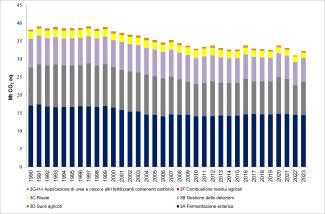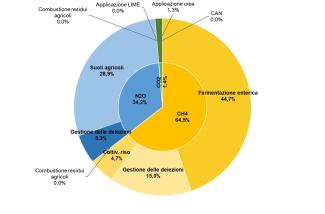Panel 1
Eleonora Di Cristofaro, Palomba Francesca
The indicator describes greenhouse gas (GHG) emissions (CH₄, N₂O, CO₂) released into the atmosphere from the agricultural sector, mainly due to livestock management and the use of fertilizers. It allows assessing the contribution of the sector to total national emissions and progress towards reduction targets. Greenhouse gas emissions from agriculture have shown a decreasing trend since 1990; however, further reduction measures will be required to meet the commitments under the United Nations Framework Convention on Climate Change (UNFCCC), the Kyoto Protocol and relevant EU Directives.
In particular, for Italy, the 2030 target set by the Effort Sharing Regulation (2023/857/EC) corresponds to a 43.7% reduction in total GHG emissions from the agriculture, residential, transport, waste and non-ETS industrial sectors, compared with 2005 levels.
In 2023, GHG emissions from agriculture accounted for 12.1% of total Effort Sharing sector emissions, while the reduction of agricultural GHG emissions compared with 2005 amounted to 8.6%
Enteric fermentation due to the digestive process—particularly in ruminants—manure management, physical, chemical and biological processes occurring in agricultural soils, rice cultivation, and the burning of agricultural residues release two key greenhouse gases into the atmosphere: methane (CH₄) and nitrous oxide (N₂O).
The agricultural sector is also responsible for carbon dioxide (CO₂) emissions resulting from the application of urea and lime to soils, as well as from the use of other carbon-containing fertilizers.
This indicator represents emissions of these agriculture-related greenhouse gases, calculated based on statistical activity data and emission factors, in accordance with the methodology developed by the Intergovernmental Panel on Climate Change (IPCC, 2006 and IPCC,2019).
CH₄ and N₂O emissions are converted into carbon dioxide equivalents (CO₂ eq.) by multiplying the emissions of each gas by its respective Global Warming Potential (GWP), which is 265 for N₂O and 28 for CH₄.
To estimate national greenhouse gas emissions produced by the agricultural sector, in order to assess their trend and the achievement of reduction targets established by current legislation. The indicator is also useful for evaluating the contribution of agriculture to total national greenhouse gas emissions
United Nations Framework Convention on Climate Change (1992), ratified by Law No. 65 of 15/01/1994;
Kyoto Protocol (1997), ratified by Law No. 120 of 01/06/2002;
CIPE Resolution of 19/12/2002; Doha Amendment to the Kyoto Protocol (2012);
Paris Agreement (2016);
Regulation (EU) 2018/1999 on the governance of the energy union and climate action (2018/1999);
Effort Sharing Decision (406/2009/EC);
Effort Sharing Regulation (2018/842/EC);
Effort Sharing Regulation (2023/857/EC).
At the European level, the reduction targets for total greenhouse gas (GHG) emissions by 2020 were set by Regulation (EU) 525/2013 on the Monitoring Mechanism of GHG emissions in the European Union, later repealed by Regulation (EU) 2018/1999 on the Governance of the Energy Union and Climate Action. This regulation defines institutions and procedures to achieve the objectives and milestones of the Energy Union, in particular the EU’s 2030 energy and climate targets.
The European Union and its Member States, under the United Nations Framework Convention on Climate Change (UNFCCC), the Kyoto Protocol, and subsequently the Doha Amendment to the Kyoto Protocol (2012) and the Paris Agreement (2016), committed to reducing their collective emissions by 20% by 2020 and by 40% by 2030 compared with 1990 levels.
Considering total emissions from the non-EU ETS sectors (agriculture, transport, residential, waste and industrial plants not covered by the EU Emissions Trading Scheme), the 2020 reduction target for Italy set by the Effort Sharing Decision (406/2009/EC), corresponding to -13% compared with 2005 GHG emissions, was achieved. The 2030 reduction target was revised upwards from -33% to -43.7% under the Effort Sharing Regulation (2023/857/EC), which replaced the previous Effort Sharing Regulation (2018/842/EC). Member State-specific targets were increased in line with the approval of the revised EU target of reducing GHG emissions by 55% by 2030 compared with 1990 levels, and with the new reduction targets for Effort Sharing sectors at the EU level (from -30% to -40% by 2030 compared with 2005).
To contribute to achieving the EU’s 2030 energy and climate objectives, the Ministry of the Environment and Energy Security (MASE) developed the Integrated National Energy and Climate Plan (PNIEC). The final updated version of the plan, submitted to the European Commission on 1 July 2024, sets out new decarbonisation pathways to 2030 in line with the Fit for 55 package.
Panel 2
- CE, 2020. Raccomandazioni della Commissione per il piano strategico della PAC dell’Italia SDW (2020) 396 final. https://www.reterurale.it/PAC_2023_27/PianoStrategicoNazionale
- IPCC, 2006. 2006 IPCC Guidelines for National Greenhouse Gas Inventories, Prepared by the National Greenhouse Gas Inventories Programme, Eggleston H.S., Buendia L., Miwa K., Ngara T. and Tanabe K. (eds). Published: IGES, Japan. URL: https://www.ipcc-nggip.iges.or.jp/public/2006gl/vol4.html
- IPCC, 2019. 2019 Refinement to the 2006 IPCC Guidelines for National Greenhouse Gas Inventories https://www.ipcc-nggip.iges.or.jp/public/2019rf/index.html.
- ISPRA, 2025 [a]. Italian Greenhouse Gas Inventory 1990-2023. National Inventory Document 2025. Rapporto ISPRA 411/2025. URL: https://emissioni.sina.isprambiente.it/wp-content/uploads/2025/04/NID_2025_Italy_Rapporto_411_2025.pdf
- ISPRA, 2025 [b]. Serie storiche delle emissioni di gas serra 1990-2023. URL: https://emissioni.sina.isprambiente.it/inventario-nazionale/
- ISPRA, 2025 [c]. Le emissioni di gas serra in Italia: obiettivi di riduzione e scenari emissivi. URL: https://www.isprambiente.gov.it/resolveuid/9f8c8e5757a04eb29d0df449f776ac92
- ISTAT, 2025. Dati annuali sulla consistenza del bestiame, sulla produzione di latte, sui mezzi di produzione, sulle coltivazioni. Istituto Nazionale di Statistica. URL: https://esploradati.istat.it/databrowser/#/it
Data quality assessment
ISPRA (Istituto Superiore per la Protezione e la Ricerca Ambientale)
ISPRA, Inventario delle emissioni in atmosfera (http://emissioni.sina.isprambiente.it/inventario-nazionale/)
National level
1990-2023
Indicator assessment
The indicator provides an estimate of national greenhouse gas (GHG) emissions from the agricultural sector, calculated according to the methodology set out in the IPCC Guidelines (IPCC, 2006; IPCC, 2019). Agricultural emissions include the following source categories: enteric fermentation, manure management, rice cultivation, agricultural soils, burning of agricultural residues, application of urea and lime to soils, and the use of other carbon-containing fertilizers.
Emission estimates are produced within the framework of the national air emissions inventory using appropriate emission factors and/or estimation models. Greenhouse gas emissions are subsequently converted into CO₂ equivalents by multiplying the emissions of each GHG by its global warming potential (GWP).
The National Inventory Document – NID (ISPRA, 2025 [a]) describes the estimation methodology and the input data, presents emission data, trend analysis and key source categories, as well as quality assurance/quality control activities and plans for improvements in the estimates. Each year, the emission data (ISPRA, 2025 [b]) are reported through the Common Reporting Tables (CRT) and the NID and submitted to the UNFCCC Secretariat.
The reduction target for 2030 set by the Effort Sharing Regulation (2023/857/EC) for Italy corresponds to a –43.7% cut in total greenhouse gas (GHG) emissions from the sectors agriculture, residential, transport, waste and industrial plants not covered by the EU ETS Directive, compared with 2005 levels. In 2023, GHG emissions from agriculture amounted to 32.3 Mt CO₂ eq., accounting for 12.1% of the total emissions from the Effort Sharing sectors. Compared with 2005, emissions from agriculture alone decreased by 8.6%. In 2023, GHG emissions from agriculture represented 8.4% of total national GHG emissions (Table 1). The breakdown by gas shows that 64.5% of emissions derived from methane, 34.2% from nitrous oxide, and only 1.4% from carbon dioxide (Figure 2).
In 2023, greenhouse gas (GHG) emissions from agriculture decreased by 15.6% compared with 1990, declining from 38.2 Mt CO₂ eq. in 1990 to 32.3 Mt CO₂ eq. in 2023. By gas, emissions of CH₄, N₂O and CO₂ decreased by 15.6%, 15.8% and 13.4%, respectively (Table 1).
By emission category, emissions from enteric fermentation (CH₄) and manure management (CH₄ and N₂O) decreased by 15.6% and 17.6%, respectively, while emissions from rice cultivation (CH₄) and agricultural soils (N₂O) fell by 27.7% and 11.8% (Figure 1).
This trend is mainly attributable to the reduction in livestock numbers for certain animal species, the decline in the use of synthetic nitrogen fertilisers, and the decrease in agricultural land and crop production.
The Common Agricultural Policy (CAP), in particular through direct support to farmers and market interventions, has played a significant role in reducing greenhouse gas emissions from agriculture (for example, the milk quota system placed a cap on milk production, leading to a reduction in livestock numbers and an increase in productivity per animal). The overall orientation of the post-2020 CAP reform is towards greater climate and environmental ambition, with the aim of contributing to the achievement of the greenhouse gas emission reduction targets set by the European Union. Under Regulation (EU) 2021/2115, adopted in the framework of the 2023-2027 CAP, Member States are required to draw up a National Strategic Plan, defining interventions and related estimated costs to contribute to the achievement of nine specific objectives and one cross-cutting objective of the future CAP (EC, 2020). In December 2022, the European Commission approved Italy’s 2023-2027 CAP Strategic Plan, which was subsequently revised and definitively approved in June 2025.
Data
Table 1: Greenhouse gas emissions from agriculture by type of greenhouse gas
ISPRA
ESD: Effort Sharing Decision,
ESR: Effort Sharing Regulation


In 2023, agriculture accounted for 8.4% of total greenhouse gas (GHG) emissions, expressed in CO₂ eq., and was therefore the second largest source of GHG emissions after the energy sector (80.3%).
In 2023, agricultural GHG emissions increased by 4.1% compared with the previous year. The analysis by gas and corresponding emission category shows that enteric fermentation (CH₄) accounted for 44.7%, agricultural soils (N₂O) for 28.9%, manure management (CH₄ and N₂O) for 20.3%—of which 15.0% from CH₄ and 5.3% from N₂O—rice cultivation (CH₄) for 4.7%, application of urea and lime and other carbon-containing fertilisers (CO₂) for 1.4%, and burning of crop residues (N₂O and CH₄) for 0.05% (Figure 2).
Methane emissions originated from enteric fermentation (69.3%), manure treatment and storage (23.3%), rice cultivation (7.3%), and crop residue burning (0.1%). Nitrous oxide emissions derived from manure management (15.4%) and agricultural soils—including emissions from the application of synthetic and organic fertilisers, incorporation of crop residues, and emissions from organic soils—which together accounted for 84.6% of N₂O emissions, while crop residue burning contributed 0.03%. Overall, the livestock sector contributed approximately 75.7% of total agricultural GHG emissions.
The marked reduction in N₂O and CO₂ emissions observed in 2022 compared with 1990 is mainly due to the decrease in the synthetic fertiliser data provided by ISTAT. These data refer to quantities sold in the country, which are assumed to be applied to agricultural soils. According to Assofertilizzanti-Federchimica, fertiliser sales in 2022 were below the annual average (for nitrogen, phosphorus and potassium), as they followed a biennium (2020–2021) of higher sales and coincided with a year when high market prices led operators to delay purchases in anticipation of falling prices, which indeed occurred in 2023.